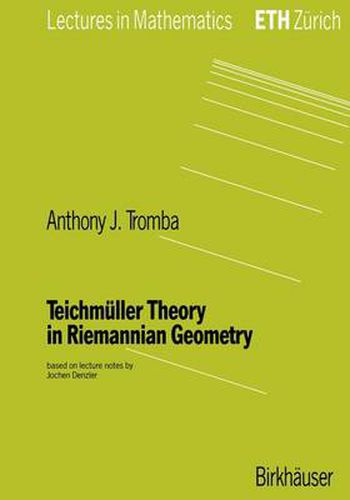Readings Newsletter
Become a Readings Member to make your shopping experience even easier.
Sign in or sign up for free!
You’re not far away from qualifying for FREE standard shipping within Australia
You’ve qualified for FREE standard shipping within Australia
The cart is loading…






This title is printed to order. This book may have been self-published. If so, we cannot guarantee the quality of the content. In the main most books will have gone through the editing process however some may not. We therefore suggest that you be aware of this before ordering this book. If in doubt check either the author or publisher’s details as we are unable to accept any returns unless they are faulty. Please contact us if you have any questions.
These lecture notes are based on the joint work of the author and Arthur Fischer on Teichmiiller theory undertaken in the years 1980-1986. Since then many of our colleagues have encouraged us to publish our approach to the subject in a concise format, easily accessible to a broad mathematical audience. However, it was the invitation by the faculty of the ETH Ziirich to deliver the ETH N achdiplom-Vorlesungen on this material which provided the opportunity for the author to develop our research papers into a format suitable for mathematicians with a modest background in differential geometry. We also hoped it would provide the basis for a graduate course stressing the application of fundamental ideas in geometry. For this opportunity the author wishes to thank Eduard Zehnder and Jiirgen Moser, acting director and director of the Forschungsinstitut fiir Mathematik at the ETH, Gisbert Wiistholz, responsible for the Nachdiplom Vorlesungen and the entire ETH faculty for their support and warm hospitality. This new approach to Teichmiiller theory presented here was undertaken for two reasons. First, it was clear that the classical approach, using the theory of extremal quasi-conformal mappings (in this approach we completely avoid the use of quasi-conformal maps) was not easily applicable to the theory of minimal surfaces, a field of interest of the author over many years. Second, many other active mathematicians, who at various times needed some Teichmiiller theory, have found the classical approach inaccessible to them.
$9.00 standard shipping within Australia
FREE standard shipping within Australia for orders over $100.00
Express & International shipping calculated at checkout
This title is printed to order. This book may have been self-published. If so, we cannot guarantee the quality of the content. In the main most books will have gone through the editing process however some may not. We therefore suggest that you be aware of this before ordering this book. If in doubt check either the author or publisher’s details as we are unable to accept any returns unless they are faulty. Please contact us if you have any questions.
These lecture notes are based on the joint work of the author and Arthur Fischer on Teichmiiller theory undertaken in the years 1980-1986. Since then many of our colleagues have encouraged us to publish our approach to the subject in a concise format, easily accessible to a broad mathematical audience. However, it was the invitation by the faculty of the ETH Ziirich to deliver the ETH N achdiplom-Vorlesungen on this material which provided the opportunity for the author to develop our research papers into a format suitable for mathematicians with a modest background in differential geometry. We also hoped it would provide the basis for a graduate course stressing the application of fundamental ideas in geometry. For this opportunity the author wishes to thank Eduard Zehnder and Jiirgen Moser, acting director and director of the Forschungsinstitut fiir Mathematik at the ETH, Gisbert Wiistholz, responsible for the Nachdiplom Vorlesungen and the entire ETH faculty for their support and warm hospitality. This new approach to Teichmiiller theory presented here was undertaken for two reasons. First, it was clear that the classical approach, using the theory of extremal quasi-conformal mappings (in this approach we completely avoid the use of quasi-conformal maps) was not easily applicable to the theory of minimal surfaces, a field of interest of the author over many years. Second, many other active mathematicians, who at various times needed some Teichmiiller theory, have found the classical approach inaccessible to them.